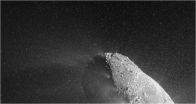LSUHSC reports first successful salivary stone removal with robotics
2010-11-19
(Press-News.org) New Orleans, LA – Dr. Rohan Walvekar, Assistant Professor of Otolaryngology Head and Neck Surgery, Director of Clinical Research and the Salivary Endoscopy Service at LSU Health Sciences Center New Orleans, has reported the first use of a surgical robot guided by a miniature salivary endoscope to remove a 20mm salivary stone and repair the salivary duct of a 31-year-old patient. Giant stones have traditionally required complete removal of the salivary gland. Building upon their success with the combination of salivary endoscopic guidance with surgery, Dr. Walvekar and his team have significantly advanced the procedure by adding robotics. The technique not only saves the salivary gland, it also reduces blood loss, scarring, and hospital stay. The case is published online in the Early View (articles in advance of print) section of the journal, The Laryngoscope.
Several factors can make removal of large stones technically challenging including a small mouth opening, large teeth, and obesity, which limit access and exposure. Limited exposure also greatly complicates the identification and preservation of the lingual nerve, which provides sensation to the tongue, as well as the placement of sutures to repair the salivary duct if necessary.
"Robot-assisted removal of stones is a technical advance in the management of salivary stones within the submandibular gland," notes Dr. Walvekar. "We have found it to be helpful in performing careful dissections of the floor of mouth preserving vital structures in this region– mainly the lingual nerve, submandibular gland and salivary duct. The use of the salivary endoscopes in addition to the robotic unit makes the procedure even safer and target oriented."
Salivary endoscopes revolutionized the management of salivary stones by allowing experienced surgeons to remove the stone while preserving the gland. The endoscopes improve surgical view, exposure and magnification of the surgical field through a two-dimensional view. The robotic unit produces a high definition, three dimensional images. The magnification and dexterity provided by the robot in the confined space of the oral cavity allow excellent identification of vital structures as well as the placement of sutures.
Stones sometimes develop from the crystallization of salts contained in saliva. Salivary stones can cause a blockage resulting in a backup of saliva in the duct. This not only causes swelling, but pain, and infection. Symptoms include difficulty opening the mouth or swallowing, dry mouth, pain in the face or mouth, and swelling of the face or neck most noticeable when eating or drinking. Salivary stones are most common in adults and it has been estimated that about a quarter of people with stones have more than one. Salivary stones most often affect the submandibular glands at the back of the mouth on both sides of the jaw.
"The robot-assisted stone removal was first devised and performed in the Department of Otolaryngology Head and Neck Surgery at LSU Health Sciences Center New Orleans," said Dr. Walvekar. "With these newer advances, mainly salivary duct endoscopy and robotic surgery, we can offer minimally invasive, gland preserving, same day, surgical procedures that represent a tremendous advance over the traditional gland removing surgery via neck incision that is recommended for this clinical condition."
INFORMATION:
Other authors include LSUHSC ENT residents Drs. Neelima Tammareddi and Geoffrey Peters, as well as Patrick Tyler, a Northwestern University medical student visiting LSU Health Sciences Center who collaborated on research and assisted in manuscript preparation.
LSU Health Sciences Center New Orleans educates Louisiana's health care professionals. The state's academic health leader, LSUHSC comprises a School of Medicine, the state's only School of Dentistry, Louisiana's only public School of Public Health, and Schools of Allied Health Professions, Nursing, and Graduate Studies. LSUHSC faculty take care of patients in public and private hospitals and clinics throughout the region. In the vanguard of biosciences research in a number of areas in a worldwide arena, the LSUHSC research enterprise generates jobs and enormous economic impact. LSUHSC faculty have made lifesaving discoveries and continue to work to prevent, advance treatment, or cure disease. To learn more, visit http://www.lsuhsc.edu and http://www.twitter.com/LSUHSCHealth.
ELSE PRESS RELEASES FROM THIS DATE:
2010-11-19
Living in a deprived area increases the risk of violence more sharply for girls than boys, according to a Cardiff University study of former industrial areas.
The new results suggest violence prevention strategies need to focus more on local inequalities, especially to protect vulnerable adolescent girls.
The survey was conducted by the Violence and Society Research Group at Cardiff University. The team studied nearly 700 young people, aged 11 to 17, who attended casualty departments in South Wales with injuries from violence. The researchers matched the patients against ...
2010-11-19
INDIANAPOLIS – A potent anti-tumor gene introduced into mice with metastatic melanoma has resulted in permanent immune reconfiguration and produced a complete remission of their cancer, according to an article to be published in the December 2010 issue of the Journal of Clinical Investigation. The online version is now available.
Indiana University School of Medicine researchers used a modified lentivirus to introduce a potent anti-melanoma T cell receptor gene into the hematopoietic stem cells of mice. Hematopoietic stem cells are the bone marrow cells that produce all ...
2010-11-19
Many studies support the assertion that moderate drinking is beneficial when it comes to cardiovascular health, and for the first time scientists have discovered that a well-known molecule, called Notch, may be behind alcohol's protective effects. Down the road, this finding could help scientists create a new treatment for heart disease that mimics the beneficial influence of modest alcohol consumption.
"Any understanding of a socially acceptable, modifiable activity that many people engage in, like drinking, is useful as we continue to search for new ways to improve ...
2010-11-19
Scientists have simulated, for the first time, the merger of two black holes of vastly different sizes, with one mass 100 times larger than the other. This extreme mass ratio of 100:1 breaks a barrier in the fields of numerical relativity and gravitational wave astronomy.
Until now, the problem of simulating the merger of binary black holes with extreme size differences had remained an unexplored region of black-hole physics.
"Nature doesn't collide black holes of equal masses," says Carlos Lousto, associate professor of mathematical sciences at Rochester Institute ...
2010-11-19
YAOUNDÉ, Cameroon (19 November 2010) – A new study finds a lack of transparency and corruption are reducing the impact of an initiative in Cameroon that channels a portion of national timber levies to rural forest communities. The study highlights the challenges of using a climate change pact to do something similar in forested regions around the world.
In an article published in the peer-reviewed journal International Forestry Review, scientists at the Center for International Forestry Research (CIFOR) examined how revenues from a tax paid by logging companies in Cameroon, ...
2010-11-19
Researchers from the Department of Cell Biology, Physiology and Immunology at Universitat Autònoma de Barcelona (UAB), in collaboration with researchers from the Institute of Microelectronics of Barcelona (IMB-CNM) of the Spanish National Research Council (CSIC), have developed an identification system for oocytes and embryos in which each can be individually tagged using silicon barcodes. Researchers are now working to perfect the system and soon will test it with human oocytes and embryos.
The research, published online in Human Reproduction, represents a first step ...
2010-11-19
Successfully treating and reversing the effects of multiple sclerosis, or MS, may one day be possible using a drug originally developed to treat chronic pain, according to Distinguished Professor Linda Watkins of the University of Colorado at Boulder.
Watkins and her colleagues in CU-Boulder's department of psychology and neuroscience discovered that a single injection of a compound called ATL313 -- an anti-inflammatory drug being developed to treat chronic pain -- stopped the progression of MS-caused paralysis in rats for weeks at a time.
Lisa Loram, a senior research ...
2010-11-19
(Santa Barbara, Calif.) –– In nature, it's a dog-eat-dog world, even in the realm of bacteria. Competing bacteria use "toxic darts" to disable each other, according to a new study by UC Santa Barbara biologists. Their research is published in the journal Nature.
"The discovery of toxic darts could eventually lead to new ways to control disease-causing pathogens," said Stephanie K. Aoki, first author and postdoctoral fellow in UCSB's Department of Molecular, Cellular, and Developmental Biology (MCDB). "This is important because resistance to antibiotics is on the rise."
Second ...
2010-11-19
Employee wellness programs have often been viewed as a nice extra, not a strategic imperative. But the data demonstrate otherwise, according to a team of researchers led by Leonard L. Berry of Texas A&M University, Ann M. Mirabito of Baylor University and William B. Baun of the University of Texas MD Anderson Cancer Center.
Their research shows that the return on investment on comprehensive, well-run employee wellness programs is impressive — sometimes as high as six to one.
The findings are compiled in a comprehensive piece in the December issue of Harvard Business ...
2010-11-19
COLLEGE PARK, Md. -- On its recent trip by comet Hartley 2, the Deep Impact spacecraft took the first pictures of, and flew through, a storm of fluffy particles of water ice being spewed out by carbon dioxide jets coming from the rough ends of the comet. The resulting images and data shed new light on the nature and composition of comets, according to the University of Maryland-led EPOXI science team, which today announced its latest findings and released the first images of this comet created snowstorm. See images at: http://epoxi.umd.edu/index.shtml
"When we visited ...
LAST 30 PRESS RELEASES:
[Press-News.org] LSUHSC reports first successful salivary stone removal with robotics



